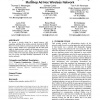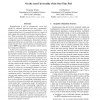101 search results - page 13 / 21 » Encrypted Message Authentication by Firewalls |
IJISEC
2010
13 years 5 months ago
2010
Physical Unclonable Functions (PUFs) are physical objects that are unique, practically unclonable and that behave like a random function when subjected to a challenge. Their use h...
SASN
2003
ACM
13 years 12 months ago
2003
ACM
We present a security design for a general purpose, selforganizing, multihop ad hoc wireless network, based on the IEEE 802.15.4 low-rate wireless personal area network standard. ...
HICSS
2002
IEEE
13 years 11 months ago
2002
IEEE
A project to enable health care professionals (GPs, practice nurses and diabetes nurse specialists) to access, via the Internet, confidential patient data held on a secondary care...
ACSC
2007
IEEE
14 years 1 months ago
2007
IEEE
Publish/subscribe networks provide an interface for publishers to perform many-to-many communication to subscribers without the inefficiencies of broadcasting. Each subscriber sub...
FOCS
2002
IEEE
13 years 11 months ago
2002
IEEE
Randomization is vital in cryptography: secret keys should be randomly generated and most cryptographic primitives (e.g., encryption) must be probabilistic. As a bstraction, it is...


